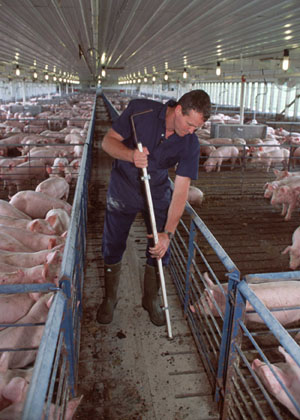 Most biosecurity plans are meant to protect animal and human health by preventing the spread of bacteria or other pathogens. Indirectly, effective biosecurity practices can reduce the likelihood of multiple or catastrophic mortalities which is an issue of environmental concern. While not usually discussed under the umbrella of “biosecurity”, manure handling should not be ignored when considering your plan. Related: Manure Pathogens
Most biosecurity plans are meant to protect animal and human health by preventing the spread of bacteria or other pathogens. Indirectly, effective biosecurity practices can reduce the likelihood of multiple or catastrophic mortalities which is an issue of environmental concern. While not usually discussed under the umbrella of “biosecurity”, manure handling should not be ignored when considering your plan. Related: Manure Pathogens
Avian Influenza | Swine PEDv | Pumping & Land Application | Inspectors | Mortalities | Recommendations by Species
Avian Influenza Resources
In 2015, millions of birds either died or had to be euthanized because of highly pathogenic avian influenza (HPAI). The approved methods of disposal for large-scale (catastrophic) mortalities include: burial, incineration, and composting.
- Managing Animal Mortalities (scroll down to see the section on catastrophic mortalities)
PEDv (Porcine Epidemic Diarrhea virus) Resources
The swine industry has experienced significant losses as a result of PEDv, which can be transmitted through contact with manure of infected pigs. It is possible to move the virus between farms on vehicles, pumps, manure handling equipment, clothing, or any other item that comes in contact with manure and is not thoroughly disinfected between farms/fields. The low amount of viral exposure required to cause illness means that even tiny amounts of residual manure pose significant biosecurity risks.
-
Archived webcast “Managing Biosecurity to Prevent PEDv“
-
The National Pork Board has fact sheets, results of research, and a newsletter including biosecure manure pumping protocols for pork producers, for commercial manure haulers, and land owners. (Spanish versions of each fact sheet are available).
- North Dakota State Extension PEDv Resources including basics about the disease and recommended biosecurity procedures
-
The American Association of Swine Veterinarians released a technical, non peer-reviewed article summarizing PEDv. The sections on transmission and treatment/prevention (including a nice summary of disinfectants).
-
New York released a very concise FAQ-type document on PEDv
Preventing Manure Pathogen Dispersal Between Farms or Field
Restricting access of off-farm equipment and personnel involved in manure pumping or manure application and thorough cleaning of equipment between farms are among the recommendations to follow to reduce risks of spreading manure-borne pathogens.
- North Dakota State Biosecure Nutrient Management. This fact sheet does an especially nice job describing how to manage and clean equipment used in manure handling around the farm.
- The National Pork Board released fact sheets on Biosecure Manure Pumping Procedures for farmers, commercial manure haulers, and land owners.
- The Maryland Department of Agriculture developed a brochure related to transporting manure and set out some guidelines to prevent the spread of pathogens.
Biosecurity for Inspectors or Technical Service Providers
What should regulatory inspectors do when traveling between farms to prevent the spread of disease? What requests can farmers make of inspectors to protect their farm biosecurity?
Biosecure Mortality Management
One of the best collections on composting animal mortalities comes from the Cornell Waste Management Institute. Check out their sections on health and safety and animal mortality composting for research on pathogen destruction and other safety considerations.
The following fact sheet was developed in response to the PEDv (porcine epidemic diarrhea virus), although these guidelines should be effective for reducing the risks related to other pathogens. It focuses on the use of rendering as the main mortality disposal method. Biosecure Mortalities Removal
Farmer & Farm Worker Biosecurity Resources
The following resources are not focused on managing manure but give a great overview of the larger biosecurity issue and practices on livestock and poultry farms.
|
This farm worker follows the farm biosecurity protocol and is wearing coveralls and boots that are cleaned and laundered on-site. |
Swine
- eXtension Following_Biosecurity_Steps_Help_Ensure_Healthy_Swine
- Pork Checkoff Biosecurity Guide for Swine Producers
- University of Missouri Biosecurity for Today’s Swine Operation
Poultry
- University of Georgia Biosecurity Basics for Poultry Growers
- USDA Biosecurity for Birds
- eXtension Backyard and small flocks
- Oklahoma State “Biosecurity for small flocks“
Dairy
- Minnesota Board of Animal Health Biosecurity for Dairy Production
- Wisconsin Veterinary Diagnostic Laboratory Biosecurity for Dairy Farms
Beef Cattle
- University of Nebraska Biosecurity Basics for Cattle Operations
- Oklahoma State University Biosecurity in the Beef Cattle Operation
Goats and Sheep
- eXtension Goat Biosecurity
- Sheep and Goat diseases (toward bottom of page)
Page Managers: Jill Heemstra, University of Nebraska and John Lawrence, Iowa State University

